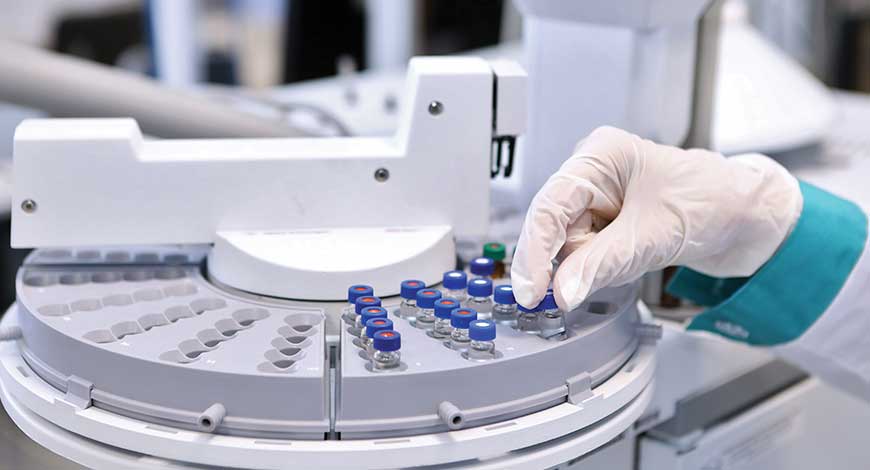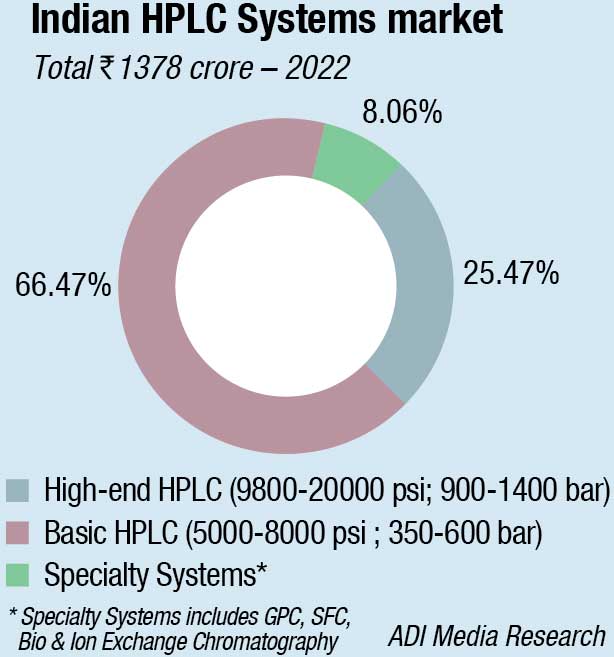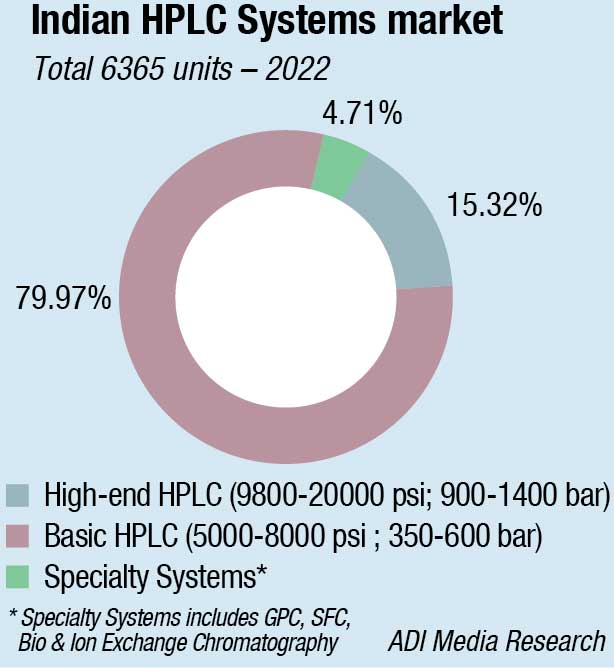HPLC Systems
Chromatography – Advancement through cutting-edge techniques

By harnessing the power of innovative technologies, chromatography has revolutionized the field, expanded its capabilities, and is driving breakthroughs in diverse domains.
Chromatography, since a century ago, has undergone remarkable technological improvements, fuelling innovation and research. It has become an indispensable tool for advancing knowledge, and has a profound impact on the well-being and health of individuals. Its high-resolution power, sensitivity, and identification capabilities have provided a solid foundation for scientific progress in various domains.
Notably, in pharmacology and biotechnology, chromatography has played a pivotal role, enabling significant innovations and advancements. From quality control to drug development, and encompassing pharmacokinetics and pharmacodynamics, chromatography has been instrumental in meeting the stringent regulatory requirements of the pharmaceutical industry, ensuring the safety and efficacy of products worldwide. Thus, the evolution of chromatography has established it as an essential tool driving breakthroughs and enhancing our understanding in diverse scientific fields, ultimately benefiting society’s wellbeing.
Indian market dynamics
The Indian HPLC market is estimated at ₹1378 crore in 2022 by value, and 6365 units by quantity. The market had declined in 2019, largely because of FDA approvals pending for most vendors. However, since then, it seems to be on track with a 9–10 percent increase per annum. It is equally dominated by three vendors, Waters, Shimadzu, and Agilent. Thermo Fisher Scientific is also aggressive in the segment.

Post Covid, operating costs have seen a major increase, primarily because of increase in price of components, lack of skilled employees, and dollar parity. The effort is toward higher productivity, higher throughput, and minimizing of the number of instruments.

New platforms have been developed, and this trend is expected to continue. The Thermo Fisher Scientific Vanquish Duo UHPLC System for Dual LC, featuring a dual split sampler and two pumps, either as separate modules or combined in the dual pump, is a case in point. The dual liquid chromatography system has the same footprint as a single instrument but contains two flow paths allowing to run the same method on both flow paths, or run two different methods simultaneously on the same instrument, improving lab productivity, sample knowledge, and overall return on investment. Shimadzu’s Nexflow technology for the Nexera system minimizes the extra-column dispersion, without changing the inner diameter or length of the piping in the UHPLC system. By suppressing peak band dispersion, UHPLC analysis with a high degree of separation and high sensitivity is achieved.
|
Indian HPLC Systems market 2022 |
||
| Leading brands | ||
| Tier I | Tier II | Others |
| Waters, Shimadzu and Agilent | Thermo Fisher Scientific | Trivitron, PerkinElmer, Hitachi, Tosoh, Knauer, Young Ling , and Jasco |
| *Vendors are placed in different tiers on the basis of their sales contribution to the overall revenues of the Indian HPLC systems market.
ADI Media Research |
||
HPLC, being a sophisticated technique in the very nature of the process that relies on gravity to pass the mobile phase through the column, results in more reliability and accuracy and is preferred over other chromatography techniques as gas chromatography. However liquid chromatography has faced major challenges of its own with the break in its supply chain and insufficient funding to research and academic institutions. Now that Covid has receded, audits have become more stringent and compliance-strict. The manufacturing practices of Indian drug makers have once again come under intense scrutiny and the USFDA’s Form 483 observations a dreaded experience. As the US economy saw a slowdown since Q1 2023, the Indian exporters have found the going tough. Investments have been delayed, and the pharma industry has seen a major decline. The food and agro verticals, along with selected sections of biotech have kept things moving.
The drug industry, seeing the strained relations between major nations, has become wary of overreliance on Chinese firms for chemical intermediates and active pharmaceutical ingredients (APIs) – particularly ingredients for patented medicines that bring in most of the industry’s profits. Moreover, Russia’s invasion of Ukraine has unsettled the decision makers, who wonder what would happen to supply chains if China took similar action against Taiwan. The drift from China is proving to be advantageous for India. The biocon industry too has enhanced its investments toward drug discovery. That in turn has provided impetus to the HPLC market.
Widespread implementation of automation continues to evade HPLCs. What is preventing wider-scale adoption of robotic approaches in the HPLC laboratory? With the advent of UHPLC, chromatographic run times are typically very short and lengthy sample preparation protocols would not match the time frame of the separative phase and the overall analysis time may be extended. Here the batch preparation robotics, with multi-head probes used in bioanalysis, may have the edge because the overall campaign time may be reduced. However, when the benefits of improved fidelity, reproducibility, and unattended operation (from fully integrated robotic solutions) are considered, even one-sample-at-a-time approach may still be of considerable benefit in HPLC analysis. Miniaturized sample preparation protocols can be very rapid indeed, when using modern automated systems with optimized processing workflows. The reasons typically cited for low adoption of automation are many, e.g., not enough budget, automation does not deliver the promised benefits, my process cannot be automated, sample preparation is too straightforward hence does not justify the expense, automated approaches cannot meet the sensitivity requirements, do not trust automation, it adds more complexity and susceptibility, etc. Yet, it cannot be contested that the flexibility of modern automated systems and the range of tasks that can be completed has been vastly improved, even in the past 10 years. Their unfaltering accuracy and repeatability are proven and their ability to reduce worker exposure to both tedium and hazardous reagents or operations can also be clearly demonstrated. And last, but not the least, the reduction in power, solvent volumes, and exposure of analytical staff to potentially harmful solvents and reagents are clear when using automated platforms. They fit the ESG agenda perfectly and allow us to clearly demonstrate that we take the future of the planet very seriously!
Global market
The global HPLC market is estimated to reach USD 8.08 billion by end of 2032, with an annualized growth rate of 5.22 percent through 2023–2032. Recent advancements in the field of high-performance liquid chromatography (HPLC) have resulted in the emergence of improved methodologies, including ultra-performance liquid chromatography (UPLC), rapid-resolution liquid chromatography (RRLC), ultra-fast liquid chromatography (UFLC), and nano liquid chromatography (Nano LC). These modern techniques offer enhanced capabilities and benefits over traditional HPLC.
UPLC, for instance, enables faster and more efficient separations, while automation enhances analysis speed and accuracy. Its high-throughput quantitative analysis makes it particularly valuable in drug development, amino acid studies, pesticide detection, herbal product evaluation, and conventional treatment testing.
These advancements, optimizing column performance, and maintaining analytical accuracy present promising growth opportunities in the market. The utilization of these cutting-edge methodologies is expected to continue driving progress in the field of liquid chromatography in the foreseeable future.
The major restraint of the market is the high cost of HPLC systems, which is responsible for stalling growth of the market.
HPLC – The Evolution

Bhaumik Trivedi
Assistant Manager – Clinical & Diagnostic Business Development,
Shimadzu Analytical (India) Pvt Ltd
The technique of high-performance liquid chromatography (HPLC) has been a favored analytical tool within the pharmaceutical industry for decades, and with the increasing adoption of techniques employing mass spectrometry (MS), HPLC shows every indication of continuing to dominate the field of analysis. Hence, HPLC system is a mandatory tool in most labs.
In the fields of medical, biological, chemical, biochemical, and phytochemicals (plant chemical research), it finds its application to analyze and quantify the molecules. HPLC has played a significant role in clinical laboratories for the separation and quantitation of biomarkers in different body fluids. HbA1c and hemoglobinopathy testing have been the biggest examples of the use of HPLC in a diagnostic lab. Many disorders related to body metabolism, those related to endocrine and exocrine gland secretion, and alteration in body fluids are diagnosed by HPLC analyses of the concerned fluids.
In recent time, nucleic acid drugs, such as antisense oligonucleotides, exert their efficacy by interacting with target genes inside and outside cells. Unlike conventional small molecule drugs, they are capable of targeting disease causes at the genetic level, and are attracting attention as a next-generation drug. The potential adsorption of such analytes onto wetted surfaces of UHPLC instruments poses some critical challenges when analyzing biomolecules. While elevated pressure tolerance is required to achieve optimal chromatographic separation, when using small particle size columns, the inertness of the wetted surfaces is also of the utmost importance, as is resistance to corrosion due to the use of mobile phases with high salt concentrations and extreme pH values. The inert system offers the ideal solution for the separation of biomolecules by combining the elevated pressure tolerance of a UHPLC system with complete inertness of the sample flow path, ensured by the absence of wetted metal surfaces and offering ultra-high resistance to corrosion.
Today, HPLC has made a cutting edge over other methods, such as immunoassay for routine estimation of vitamins, hormones, other biomarkers, and for biopharmaceuticals. The cost of such advanced analytical techniques is prohibitive but due to the advantages of ultra-high sensitivity, capability to handle heavy workloads, control of operational cost, and the returns on investment are recovered easily by laboratories through high profits, higher confidence, and efficient services.
Regional insights. North America accounts for the largest revenue share of over 31 percent in 2022, and this is as a result of the growing pharmaceutical industry as well as the increasing occurrence of various disorders. Moreover, the presence of key companies is also likely to contribute to the regional growth of the HPLC market within the estimated timeframe.
Clinical applications of HPLC – An overview

Dr Shaloo Kapoor
Chief Pathologist & Senior DGM,
SRL Limited, Fortis Heart Institute
Clinical applications of HPLC – An overview High-performance liquid chromatography (HPLC), also known as high-pressure liquid chromatography, is an advanced, automated, versatile, rapid, reproducible and ever-evolving technology, used in analytic chemistry. Since Russian scientist Mikhail Tsvet invented chromatography in 1900, various advancements and innovations have been done related to HPLC.
HPLC analysis is classified into normal column-type with polar stationary phase, reverse-type with polar mobile phase, size-exclusion (SEC)-type based on separation of molecules according to size and ion-exchange(IEX)-type based on separation of molecules according to their charge. HPLC in normal phase works by allowing pumps to pass a pressurized ~400 bar low-polarity solvent and a sample mixture through a high-polarity column filled with adsorbent, with separation of the sample constituents of different affinity. The composition of the mobile phase may be constant (isocratic elution mode) or varied (gradient elution mode) in chromatographic analysis. HPLC is also categorized into affinity chromatography, adsorption chromatography, partition chromatography, and chiral-phase chromatography. The apparatus of a typical liquid chromatograph system includes a pump, autosampler, analytical column compartment, degassing unit, detector, and data processor. Reverse-phase chromatography, based on principle of hydrophobic interactions, uses very small particles (<10 µm), high-pressure, low-pulsation pump, which has better separation performance and accuracy with small amount of sample.
Clinical applications
HPLC usage in diagnostics include identification of diverse range of analytes. HPLC is routinely used to measure therapeutic drug levels, including immunosuppressive drugs, detection of drugs of abuse, analysis of catecholamines, and separation of proteins or determination of amino acid metabolism. HPLC is used for quantitative estimation of glycated hemoglobin and allows identification of hemoglobin variants for screening of hemoglobinopathies as well as providing precise measurement of HbA2 and HbF. It is also used for porphyrins speciation in urine and estimation of various vitamins along with biomarkers in diagnostic labs.
Recent trends
Ultra-high performance liquid chromatography platform, using higher pressure (1000–1500 bar), smaller particle (<10 µm size), detectors with higher sensitivity, increased flow rate has improved separation efficiencies, more throughput, and less analysis time. Limitations include high backpressure and its fluctuations, causing column degradation, and higher maintenance costs.
UHPLC offers remarkable advantages, including astonishingly short analysis times and reduced solvent usage as the mobile phase. It achieves higher separation efficiency and improved resolution of analyte mixtures. The key differentiating factor of UHPLC is the utilization of column packing particles smaller than 2 micron.
Applications include quantification of target analytes and analysis of monoclonal antibodies.
With implementation of sophisticated techniques like more sensitive detector, HPLC systems are incorporating modules using dual pump to offer workflows that increase productivity in a single system – dual LC, tandem LC particularly useful in toxicology screening.
Latest innovations like hyphenated techniques combine physical separation properties of liquid chromatography (or HPLC) with the spectral properties of MS (mass spectrometry), which have benefits of analyzing multiple analytes within a mixture having complex matrix. Advantages include quicker results and more accurate analysis. Coupling techniques-based platform is used for neonatal screening for metabolic disorders, to perform element and drug speciation in blood, urine, as well as body fluids. Clinical research is ongoing to identify metabolites in Parkinson’s and cardiac disease biological samples to use them as biomarkers.
Lot of research is being done on total analysis systems (microTAS) with on-chip integration of HPLC and fluidics, emerging toward miniaturization and automation of techniques, allowing for faster and more efficient separations, increasing throughput at lower cost, expanding scope of applications of HPLC with exciting future ahead!
The European market is projected to have the second-highest share in the global high-performance liquid chromatography (HPLC) market. This growth is driven by increased awareness of HPLC procedures, government regulations, and the utilization of HPLC in bioinformatics and DNA fingerprinting. Moreover, the high sensitivity and precision of HPLC make it valuable for law enforcement authorities in detecting performance-enhancing drugs in urine, thereby boosting market growth in Europe.
The Asia-Pacific region is projected to have the fastest CAGR in the HPLC market during the forecast period. This is attributed to the significant patient population, which is driving demand for pharmaceutical products and healthcare services. The manufacturing of generics in countries, such as India and China, is also expected to increase the adoption of HPLC for testing and quality control.
Moreover, there is a growing investment in research and development (R&D) in the healthcare industry, and the need to advance this sector is expected to support the growth of the HPLC market in the region.
Some of the prominent players operating in the global HPLC market are Thermo Fisher Scientific, Inc., Agilent Technologies, Inc., Shimadzu Corporation, Sartorius AG, Merck KGaA, Waters, YOUNGIN Chromass, Phenomenex, Inc., PerkinElmer Inc., Tosoh Bioscience, KNAUER Wissenschaftliche Geräte GmbH, Sykam GmbH and Others.
Industry updates
In July 2022, MicroSolv Technology Corporation, a prominent manufacturer of HPLC columns and products for separation sciences, has completed the acquisition of Applied Research Europe GmbH, a manufacturer of chromatography accessories, based in Berlin, Germany.
This strategic move is expected to bolster MicroSolv’s manufacturing capabilities and enhance their expertise, enabling the development of new innovations for separation science laboratories
Challenges in HPLC
High-performance liquid chromatography (HPLC) technology offers significant advantages, such as the utilization of fine particles (<10 m), a uniform stationary phase, low mass transfer impedance, and high separation efficiency. These features, combined with a high-pressure infusion pump for efficient mobile phase transport, enable rapid analysis.
Moreover, HPLC employs highly sensitive detectors, improving detection capabilities. However, like any analytical method, HPLC presents challenges, including peak splitting, tailing, and fronting during analysis. These issues can be attributed to factors, such as suboptimal column performance, improper mobile phase composition, and sample matrix effects.
To address these challenges, meticulous HPLC system maintenance and optimization of mobile phase composition, sample preparation, and injection techniques are crucial for accurate analyses.
In the field of pharmaceutical analysis, HPLC is a prominent technique utilized for both qualitative and quantitative drug analysis. In fact, more than 90 percent of drugs listed in official pharmacopoeias undergo HPLC analysis. However, the pharmaceutical industry faces increasing regulatory requirements, necessitating advanced chromatographic techniques. These requirements encompass a larger sample volume, enhanced analysis speed, and improved method sensitivity. As a result, pharmaceutical industries are embracing more advanced approaches to meet these demanding regulatory standards.
Bridging the gap from HPLC to UHPLC
The development of ultra-high performance liquid chromatography (UHPLC) stems from the growing demand for rapid and highly effective separation techniques with enhanced resolution. UHPLC represents a significant advancement, providing analysts with quick analytical separations, while maintaining the high-quality outcomes previously attained by HPLC.
Future of HPLC
HPLC has been a crucial technique in the pharmaceutical, chemical, and biological industries for many years. Due to technological advancements and emerging applications, the future of HPLC is promising.
Green HPLC. The trend toward environmentally friendly or green HPLC is gaining momentum. It involves developing methods through the use of alternative solvents, reduced solvent consumption, and solvent recycling.
Chromatography has evolved into a vital tool for scientific progress, and its applications in various fields, including pharmacology and biotechnology, have led to significant advancements. The emergence of advanced methodologies, such as UHPLC, has further enhanced the capabilities and benefits of chromatographic analysis.












